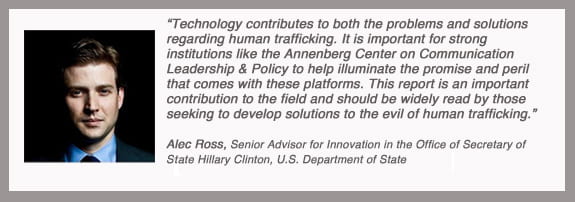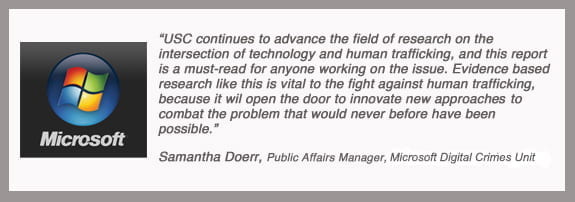The Technology and Human Trafficking Initiative is a project of the USC Annenberg Center on Communication Leadership and Policy created to study the current use and broader implementation of information and communication technologies in the international fight against human trafficking and modern slavery.
New study: Isolation from technology and social networks increases risk of labor trafficking
Download the full report (PDF)
Migrant workers who are isolated from technology and social networks are more vulnerable to human trafficking, forced labor, and exploitation. These and other findings are detailed in a powerful new report, Technology and Labor Trafficking in a Network Society, released today by the Center for Communication Leadership & Policy (CCLP) at the University of Southern California’s Annenberg School for Communication & Journalism. This project was made possible by a grant from Humanity United, a U.S.-based foundation dedicated to building peace and advancing human freedom.
Current Projects:
- Technology and Labor Trafficking in a Network Society funded by Humanity United
- Anti-Human Trafficking Communication And Social Media in Indonesia funded by USAID
- Research on Data Analytics and Child Sex Trafficking, funded by the Department of Justice.
The Reports
- Technology and Labor Trafficking in a Network Society (2015)
- The Rise of Mobile and the Diffusion of Technology-Facilitated Trafficking (2012)
- Human Trafficking Online: The Role of Social Networking Sites and Online Classifieds (2011)
Since launching its Technology and Human Trafficking Initiative in 2010, the Annenberg Center on Communication Leadership & Policy has produced groundbreaking research on technology and human trafficking. In 2011, the Annenberg Center released the first in-depth examination of the role of social networking sites and online classifieds in the domestic sex trafficking of minors. This report was followed in 2012, with the publication of The Rise of Mobile and the Diffusion of Technology-Facilitated Trafficking, which was the first effort of its kind to examine the role of mobile technology in both facilitating and combatting trafficking.


